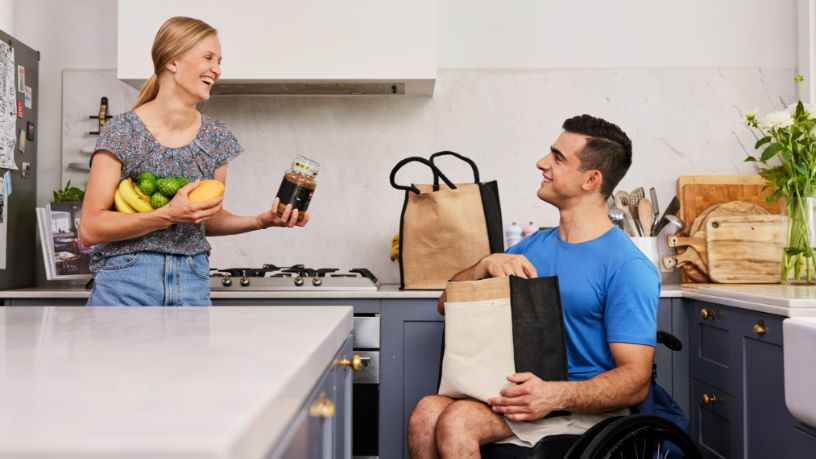Excess fat around the middle can increase your risk of heart disease, diabetes and some cancers.
On this page
Key takeaways
Boost your intake of whole foods like vegetables, fruit and wholegrains to help with weight loss.
Being more active can help us maintain a healthy weight.
When we talk about wanting to be a healthier weight, what we really mean is we want to reduce the amount of body fat we have.
Lean muscle weighs quite a bit, but we need that to stay feeling and looking fit and healthy.
Meanwhile, we do actually need some body fat1 to keep our bodies warm and functional, but too much of it isn’t so great for long-term health.
Excess weight around our middle can be a sign that we have too much visceral fat in our bodies. Also known as ‘toxic fat’, this type of fat sits on or around our major organs and puts us at a greater risk of conditions such as heart disease, type 2 diabetes and some cancers.2
Targeting a specific area of the body to lose weight from is almost impossible, but there are steps you can take to help reduce belly fat over time.
Burn more calories than you eat and drink
If you want to lose weight, you need to eat and drink fewer calories (or kilojoules) than you burn.
“You don’t need to count calories or track macros,” says Bupa dietitian, Heather Ko. “You can get into a calorie deficit by simply making sustainable changes to your diet.”
Ko suggests gradually reducing your meal portions by around one third to one quarter.
“It may not sound like much, but by the end of the day your total calorie intake has reduced significantly.”
Generally speaking, you can aim for a 500 calorie (2000 kilojoule) daily deficit.3 The number of calories you should be consuming in a day will vary depending on your gender, age and lifestyle. An adult male who works at a desk all day will need a different amount than an adult female personal trainer.
Eat more whole foods
Whole or unprocessed foods are the key to a healthy diet. They’re a source of fibre, minerals and vitamins, and they can help you stay fuller for longer.
“Whole foods generally use more energy to break down,” says Ko. “This means you burn more calories digesting and absorbing whole foods compared to foods that have had most of their processing done for you.”
Ko adds that processed foods that are high in fat and sugar will also cause your glucose levels to spike, causing your body to release insulin.
“High levels of insulin signal the body to store fat, especially around the abdomen.”
Whole foods usually don’t contain any added sugars, salt, starches or flavourings. They include whole grains, fruit and vegetables, nuts and seeds, minimally processed dairy, and unprocessed meat.
Eat protein
Protein can help you lose weight by making you feel fuller for longer. You’ll find protein in eggs, milk, cheese and yoghurt, lean meats, poultry, fish, legumes (beans and lentils), nuts and seeds.
Protein may also:
- boost your metabolism (helping you burn more calories)
- help to build muscle mass
- keep your bones healthy (reducing your risk of osteoporosis)
- help your body repair after an injury.
Fill half your plate with (the right!) veggies
“You’ve heard it over and over again,” Ko says. “Eat your vegetables!”
Low in calories and high in fibre, minerals and vitamins, vegetables are a fundamental part of maintaining a healthy weight.
Ko suggests filling half of your lunch and dinner plate with non-starchy veggies, as opposed to high-starch ones likes potatoes, peas and corn.
Non-starchy vegetables include:
- broccoli
- zucchini
- asparagus
- leafy greens
- cauliflower
- spinach
- celery
- eggplant
- mushrooms
- onions
- capsicum.
Do some exercise
People trying to lose belly fat might do some extra crunches or sit-ups, but don’t let yourself fall into this ‘spot reduction’ workout myth.
“Abdominal workouts alone won’t help you lose belly fat. We can’t target where we lose weight,” says Ko.
Instead, you simply need to move, mixing your workouts up between cardio (the kind of activity that raises your heartbeat and leaves you feeling a bit breathless) and resistance training4, which helps to build lean muscle and increase overall strength.
“Strength training can also increase your metabolism and helps you burn more calories, even while you’re at rest,” Ko says.
If you’re new to exercise, consider getting a personal trainer to create a workout plan for you, visit a local gym for advice, or look online for workout plans that suit your level of fitness.
Increase your incidental exercise
“When people start their fat-loss journey, they may dedicate one hour to exercise each day. But what happens to the remaining 23 hours?” Ko asks.
People who lead largely sedentary lifestyles are at greater risk of obesity.5
If you’re committed to losing belly fat, Ko suggests looking at ways you can move more throughout the day, otherwise known as your incidental exercise.
“Stand up more often, clean the house, pace while on the phone,” she says. “The cumulative impact of a multitude of activities can help you to lose weight.”
Other easy ways to increase your incidental exercise include:
- having walking meetings instead of sit-downs at work
- choosing a coffee shop a few extra blocks away
- parking further away from the shops
- taking public transport instead of the car
- taking the stairs instead of the lift.

At Bupa, trust is everything
Our health and wellbeing information is regularly reviewed and maintained by a team of healthcare experts, to ensure its relevancy and accuracy. Everyone's health journey is unique and health outcomes vary from person to person.
This content is not a replacement for personalised and specific medical, healthcare, or other professional advice. If you have concerns about your health, see your doctor or other health professional.
1LeWine, H. E. (2023). What is considered a healthy body fat percentage as you age?. Harvard Medical School, Harvard Health Publishing.
2Healthdirect. (2023). How to reduce visceral body fat (hidden fat). Healthdirect.
3Koliaki, C., Spinos, T., Spinou, Μ., Brinia, Μ. E., Mitsopoulou, D., & Katsilambros, N. (2018). Defining the Optimal Dietary Approach for Safe, Effective and Sustainable Weight Loss in Overweight and Obese Adults. Healthcare (Basel), 6(3), 73.
4Better Health Channel. (2022). Resistance training – health benefits. Victoria State Government, Department of Health.
5Villablanca, P. A., Alegria, J. R., Mookadam, F., Holdmer Jr, D. J., Wright, R. S., & Levine, J. A. (2015). Nonexercise Activity Thermogenesis in Obesity Management. Mayo Clinic Proceedings, 90(4), 509-519.
You might also like...
5 tips to start exercising (and stick with it)
Exercising regularly is one of the best things you can do for your health, but it’s not always easy to get started. Try these 5 tips to help get moving.
How to lose weight and keep it off
Find out ways to help you lose weight effectively, and, most importantly, keep it off.
50 healthy food swaps
Small changes to your diet can have a big impact on your health. To make it easy, we’ve put together 50 healthier food swaps you can make for the whole family.
Healthier versions of your favourite comfort food
Eating a healthier diet doesn’t mean you have to give up all your favourite comfort foods. Check out these recipe tips for delicious, nutritious meals.





